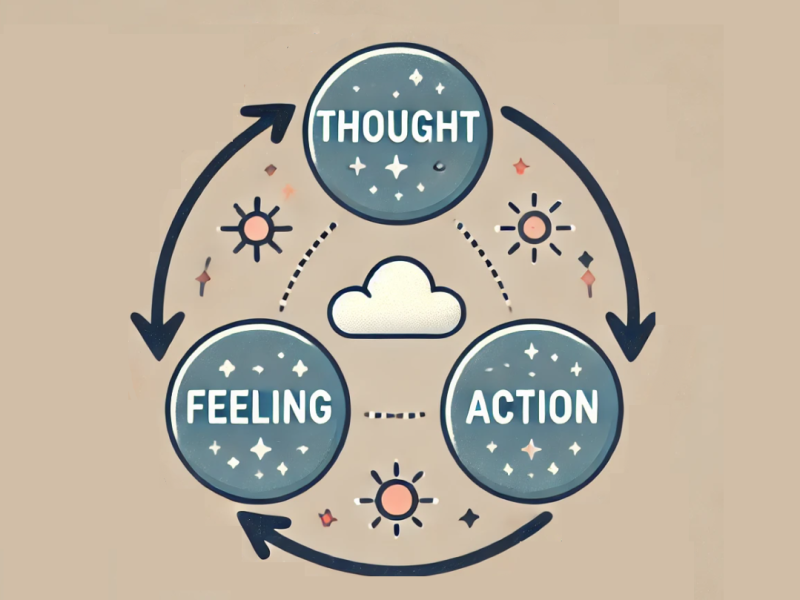Comprehensive Guide to Cognitive Behavioral Therapy (CBT)
On this page, you can learn more about CBT. On our platform, you can connect with licensed therapists specializing in CBT through online sessions. Click the button below to get started:

Introduction to Cognitive Behavioral Therapy
Cognitive Behavioral Therapy (CBT) is a widely recognized and evidence-based approach to mental health treatment. CBT is designed to help individuals understand and change negative thought patterns and behaviors that contribute to emotional distress. It is an effective therapy for a variety of mental health conditions, including anxiety, depression, and stress. This guide provides an in-depth look at CBT, exploring its history, techniques, benefits, and practical applications.
History and Development of CBT
Origins of CBT
Cognitive Behavioral Therapy (CBT) has its roots in both cognitive psychology and behavioral psychology. Developed in the 1960s by Dr. Aaron T. Beck and Dr. Albert Ellis, CBT emerged as a structured approach to treating mental health disorders. Beck’s work on cognitive distortions and Ellis’s Rational Emotive Behavior Therapy (REBT) laid the groundwork for modern CBT practices.
Evolution Over Time
Since its inception, CBT has undergone significant evolution. Early models focused on simple behavioral techniques, while contemporary CBT incorporates complex cognitive strategies. Research and clinical practice have refined CBT into a robust framework that addresses a wide range of psychological issues.
Major Milestones
Key milestones in CBT’s development include the introduction of cognitive restructuring techniques and the expansion of CBT to treat various disorders beyond depression and anxiety. Studies demonstrating its effectiveness have solidified CBT’s place as a leading therapeutic approach.
How Cognitive Behavioral Therapy Works
The CBT Model
Cognitive Behavioral Therapy operates on the principle that our thoughts, feelings, and behaviors are interconnected. Negative thought patterns often lead to emotional distress and unhelpful behaviors. CBT helps individuals identify and challenge these cognitive distortions, replacing them with more balanced and realistic thoughts.
Typical CBT Session Structure
A typical CBT session involves setting goals, identifying negative thought patterns, and practicing new coping strategies. Sessions often include exercises such as thought records and behavioral experiments to help individuals test and alter their beliefs and behaviors.
Common CBT Techniques
- Cognitive Restructuring: Identifying and challenging irrational or distorted thoughts.
- Exposure Therapy: Gradually facing feared situations to reduce avoidance and anxiety.
- Behavioral Experiments: Testing beliefs and assumptions through real-life experiments.
Common Applications of CBT
Treating Anxiety Disorders
CBT is highly effective in treating various anxiety disorders, including generalized anxiety disorder (GAD), social anxiety disorder, and panic disorder. Techniques such as exposure therapy and cognitive restructuring help individuals manage and reduce anxiety symptoms.
Managing Depression
Cognitive Behavioral Therapy is a proven treatment for depression. CBT helps individuals identify negative thought patterns that contribute to their mood and teaches strategies to counteract these thoughts, leading to improved mood and functioning.
Applications for PTSD, OCD, and More
CBT is also beneficial for conditions like post-traumatic stress disorder (PTSD) and obsessive-compulsive disorder (OCD). Tailored techniques, such as trauma-focused CBT and exposure and response prevention (ERP), address specific symptoms and improve quality of life.
CBT for Children and Adolescents
CBT can be adapted for younger populations, helping children and adolescents manage issues like anxiety, depression, and behavioral problems. Techniques are modified to be age-appropriate and engaging.
Benefits of Cognitive Behavioral Therapy
Evidence of Effectiveness
Numerous studies and clinical trials have demonstrated the effectiveness of CBT in treating a wide range of mental health conditions. Research shows that CBT can significantly reduce symptoms of anxiety, depression, and other disorders.
Personal Stories and Testimonials
Many individuals have found CBT transformative in their lives. Personal stories often highlight how CBT has helped them overcome challenges, manage stress, and achieve long-term mental wellness.
Comparison with Other Therapies
Compared to other therapeutic approaches, such as psychodynamic therapy or medication, CBT offers a structured and goal-oriented approach. It focuses on developing practical skills and strategies that can be used in daily life.
CBT Techniques and Strategies
Common Exercises
- Thought Records: Tracking and challenging negative thoughts to promote cognitive change.
- Behavioral Experiments: Testing the validity of negative beliefs through real-life trials.
- Activity Scheduling: Planning and engaging in enjoyable activities to improve mood and reduce avoidance.
Techniques for Challenging Negative Thoughts
CBT provides tools for identifying cognitive distortions, such as all-or-nothing thinking or catastrophizing. Techniques involve evaluating the evidence for and against these thoughts and developing more balanced perspectives.
Coping Strategies and Skill-Building
CBT equips individuals with coping strategies to manage stress and emotional challenges. Skills such as problem-solving, relaxation techniques, and assertiveness training are integral to the CBT process.
Finding a CBT Therapist
How to Find a Qualified CBT Therapist
Finding a qualified CBT therapist involves researching professionals with specific training in CBT. Look for therapists with certifications from reputable organizations and experience in treating your specific concerns.
What to Look For
When choosing a CBT therapist, consider their qualifications, experience, and approach. Ensure they use evidence-based CBT techniques and have a collaborative style that fits your needs.
Questions to Ask During a Consultation
Prepare questions about the therapist’s experience with CBT, their approach to treatment, and what you can expect from sessions. This will help you determine if the therapist is a good fit for you.
Online Therapy Options
Many individuals now access CBT through online platforms. Online therapy can provide convenience and flexibility while maintaining the effectiveness of traditional face-to-face sessions.
CBT Resources and Tools
Recommended Books and Workbooks
- “Feeling Good: The New Mood Therapy” by David D. Burns
- “The CBT Toolbox: A Workbook for Clients and Clinicians” by Lisa Dion
Mobile Apps for CBT
- Moodfit
- CBT Thought Record Diary
Online Courses and Webinars
Explore online courses and webinars that offer CBT training and self-help strategies. Many reputable organizations provide educational resources to help individuals understand and apply CBT principles.
Self-Help Resources and Support Groups
Online support groups and self-help resources can complement formal CBT therapy. They provide community support and additional tools for managing mental health.
FAQ About Cognitive Behavioral Therapy
Common Questions
- What is the duration of CBT? CBT typically involves 12-20 sessions, though the exact number may vary based on individual needs.
- Is CBT effective for everyone? While CBT is highly effective for many, its success can vary depending on individual factors and the specific issue being addressed.
Misconceptions and Clarifications
Some people believe CBT is only for severe mental health issues or that it involves only talking about problems. In reality, CBT is a practical, goal-oriented therapy with a wide range of applications and techniques.
What to Expect from CBT
Expect a collaborative process where you work with your therapist to set goals, identify negative thought patterns, and develop coping strategies. CBT is structured, but also tailored to your unique needs.
Conclusion
Cognitive Behavioral Therapy (CBT) offers a practical and effective approach to managing mental health issues. By understanding the principles, techniques, and benefits of CBT, you can make informed decisions about seeking therapy. If you’re struggling with emotional distress, consider reaching out to a CBT therapist or exploring CBT resources to start your journey toward mental well-being.
References and Further Reading
- Beck, A. T. (1976). Cognitive Therapy and the Emotional Disorders. International Universities Press.
- Ellis, A. (1962). Reason and Emotion in Psychotherapy. Lyle Stuart.
- National Institute for Health and Care Excellence (NICE). Guidelines on CBT for Depression and Anxiety. NICE Guidelines
Remember that help is available!
If you are struggling with mental health issues, you are not alone. On our online platform, you can connect with a licensed professional today. Click the button to get started.


